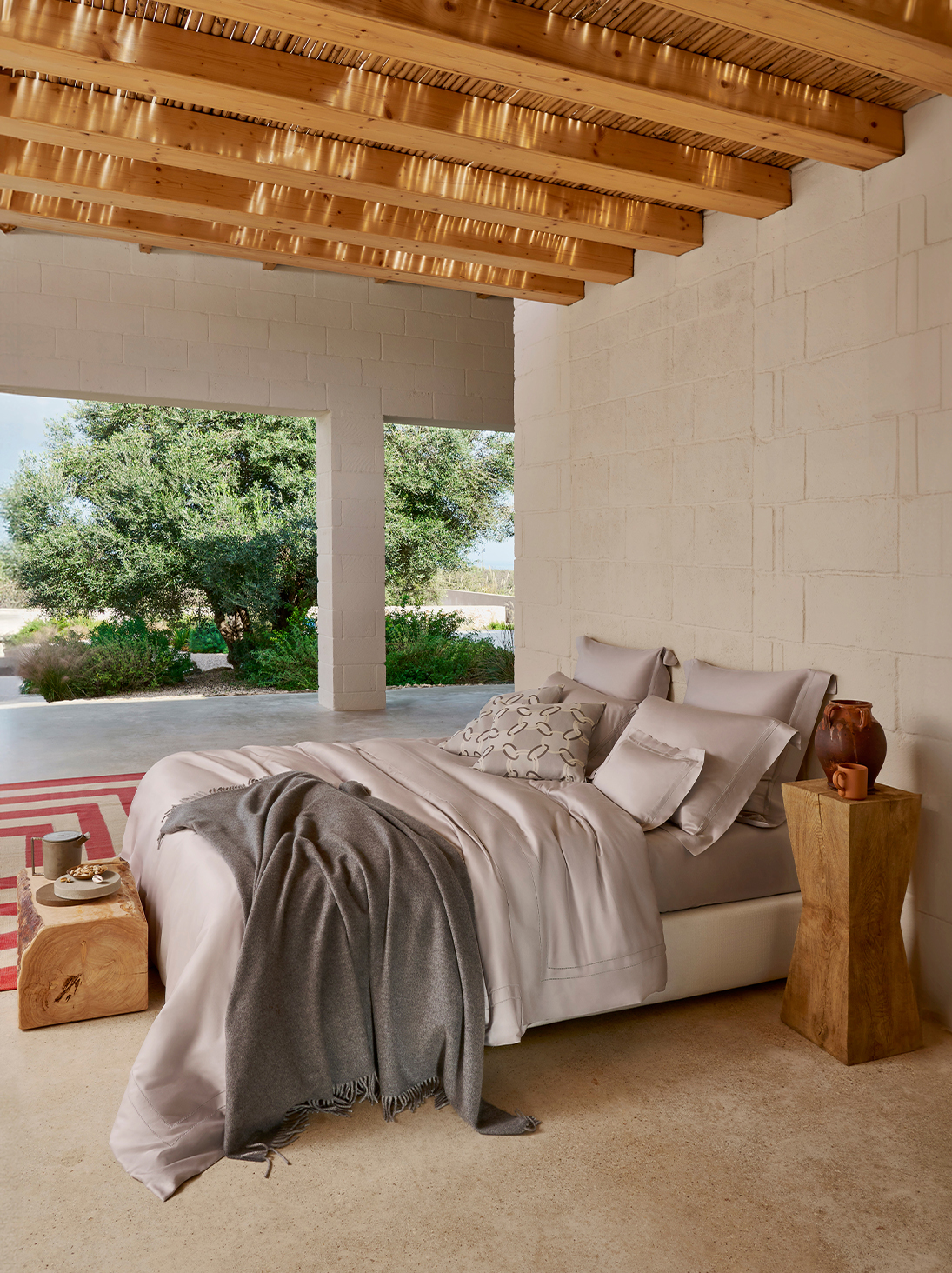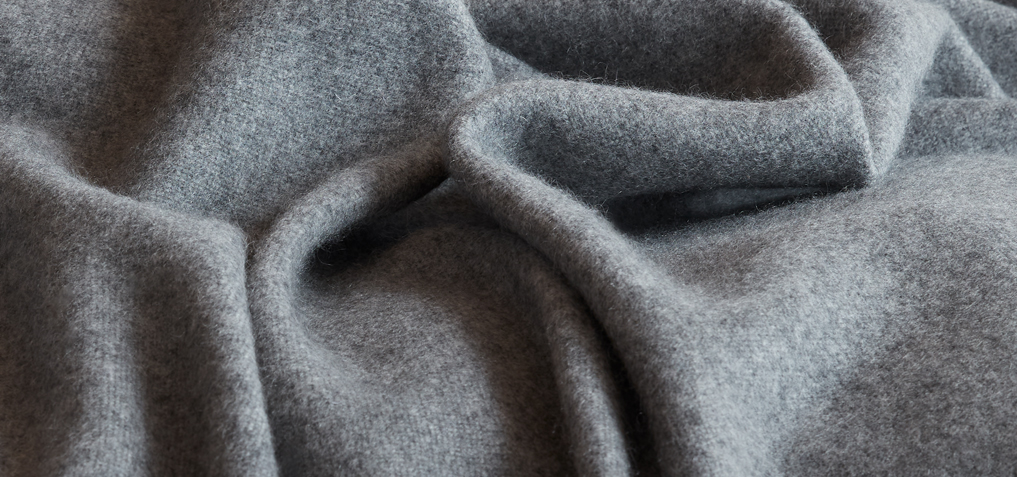
Welcome to the World of Fine Linens
HOW DO YOU LIKE TO SLEEP?

What are The 3 f’s?
Thread count measures threads per square inch and produces various results of texture and breathability. The higher the thread count, the less air flow; thus, sateens sleep warmer than percales.
Additional finishing touches may include embroidery, lace, and other embellishments.
Nº1
Fibre
When choosing the best sheets to buy, first consider the fibre used to weave those linens. Cotton
quality
depends on fibre length - longer fibres make a more uniform, resistant and smoother thread.
Thread count measures threads per square inch and produces various results of texture and breathability.
The
higher the thread count, the less air flow; thus, sateens sleep warmer than percales.
Nº2
Finish
Next, consider the finish of the fabric. The hand, or silkiness, of a fabric is not a result of thread
count, but rather the finishing process - a treatment to the woven fabric to increase durability or
shine.
Frette fabrics go through a patented finishing process to create the super smooth and lustrous finish
unlike
any other.
Additional finishing touches may include embroidery, lace, and other embellishments.
Nº3
Feel
Feel is the texture and weight of the finished product, determining its best use. The best bedding material is one that feels comfortable to sleep in depending on the weather, the surroundings, and body heat. Some prefer to be wrapped in soft, silky sheets like cotton sateen, while others prefer crisp, airy linens like cotton percale.
CARE GUIDE



To begin, sort cotton linens by colour (whites, light colours, dark colours) and category (sheets, towels, tablecloths). Do not include items made of synthetic fibres nor garments with components that may damage fabrics (zippers, hooks, metal parts). When loading the machine, ensure items are unfolded.
Delicate items with lace and embroidery should be enclosed in a large, lightweight mesh laundry bag. Pillowcases and duvet covers should be washed inside out to protect embellishments.
Wash in cold water. When the wash cycle is complete, remove linens immediately and shake to minimise wrinkles.



Frette cotton is selected to achieve the optimal balance of strength, softness, longevity and comfort. To preserve these qualities, select mild biodegradable liquid detergent free of bleach and whiteners. Avoid powdered detergent or detergents containing alkali and make sure detergent is fully dissolved before water touches the fabric. The amount of detergent needed depends on the linens’ soil level and the water’s hardness.



When machine drying, never dry at high temperatures. If your dryer is adjustable, use the medium temperature fan and medium spin speed. For bed linens,remove from the dryer before completely dry, gently lay flat on an ironing board, then iron.
When line drying, open each item and shake before hanging. Do not place articles in direct sunlight as sunlight will cause colours to fade and white to yellow.



When ironing cotton, use a steam iron on a warm/high setting. For embroidered linens, iron items on the reverse side and whilst damp for best results. Avoid using spray starch.






After ironing, store cotton folded flat in a cool, dry, well-ventilated area. Cottons stored long-term should avoid being stored in plastic bags and boxes as natural fibres need to breathe. Make sure stored cottons are not exposed to direct sunlight, which can cause permanent yellowing. For a crisp clean scent, store with a scented sachet.



To begin, sort linens by colour (whites, light colours, dark colours) and category (sheets, towels, tablecloths). Do not include items made of synthetic fibres nor garments with components that may damage fabrics (zippers, hooks, metal parts). When loading the machine, ensure items are unfolded.
Delicate items with lace and embroidery should be enclosed in a large, lightweight mesh laundry bag. Pillowcases and duvet covers should be washed inside out to protect embellishments.
Wash in cold water. When the wash cycle is complete, remove linens immediately and shake to minimise wrinkles.



Frette linen is selected to achieve the optimal balance of strength, softness, longevity and comfort. To preserve these qualities, select mild biodegradable liquid detergent free of bleach and whiteners. Avoid powdered detergent or detergents containing alkali and make sure detergent is fully dissolved before water touches the fabric. The amount of detergent needed depends on the linens’ soil level and the water’s hardness.



When machine drying, never dry at high temperatures. Use the low temperature fan and low spin speed settings. Remove from the dryer when damp, then line dry.
When line drying, open each item and shake before hanging. Do not place articles in direct sunlight as sunlight will cause colours to fade and white to yellow.



When ironing linen, use a steam iron on a warm/high setting. For embroidered linens, iron items on the reverse side and whilst damp for best results. Avoid using spray starch.






After ironing, store linen folded flat in a cool, dry, well-ventilated area. Linens stored long-term should avoid being stored in plastic bags and boxes as natural fibres need to breathe. Make sure stored linens are not exposed to direct sunlight, which can cause permanent yellowing. For a crisp clean scent, store with a scented sachet.












When ironing silk, use a steam iron on a low setting. For embellished linens, iron items on the reverse side. Do not use spray starch.



Delicate fibres such as silk are best professionally cleaned. To avoid excessive shrinkage on top-of-the-bed pieces, such as light quilts, bedspreads, and blankets, dry cleaning is recommended. Be sure to use professional dry cleaners who have experience with luxury linens and natural fibres.



Store silk folded flat in a cool, dry, well-ventilated area. Silks stored long-term should avoid being stored in plastic bags and boxes as natural fibres need to breathe. Make sure stored silks are not exposed to direct sunlight, which can cause permanent yellowing. For a crisp clean scent, store with a scented sachet.












To preserve the natural fibres of wool, when ironing, use a steam iron on a low setting. Do not over iron or keep the iron on the fabric for prolonged periods of time, as this will result in scortching. A piece of cotton may use between iron and wool to prevent damage. Do not use spray starch.



Delicate fibres such as wool are best professionally cleaned. To avoid excessive shrinkage on top-of-the-bed pieces, such as light quilts, bedspreads, and blankets, dry cleaning is recommended. Be sure to use professional dry cleaners who have experience with luxury linens and natural fibres.



Store wool folded flat in a cool, dry, well-ventilated area. Wools stored long-term should avoid being stored in plastic bags and boxes as natural fibres need to breathe. Make sure stored wools are not exposed to direct sunlight, which can cause permanent yellowing. For a crisp clean scent, store with a scented sachet.















Delicate fibres such as cashmere are best professionally cleaned. To avoid excessive shrinkage on top-of-the-bed pieces, such as light quilts, bedspreads, and blankets, dry cleaning is recommended. Be sure to use professional dry cleaners who have experience with luxury linens and natural fibres.



Store cashmere folded flat in a cool, dry, well-ventilated area. Cashmeres stored long-term should avoid being stored in plastic bags and boxes as natural fibres need to breathe. Make sure stored cashmeres are not exposed to direct sunlight, which can cause permanent yellowing. For a crisp clean scent, store with a scented sachet.



To begin, sort cotton terry by colour (whites, light colours, dark colours). Do not include items made of synthetic fibres nor garments with components that may damage fabrics (zippers, hooks, metal parts). When loading the machine, ensure items are unfolded.
Delicate items with lace and embroidery should be enclosed in a large, lightweight mesh laundry bag.
Wash in cold water. When the wash cycle is complete, remove linens immediately and shake to minimise wrinkles.



Frette cotton terry is selected to achieve the optimal balance of strength, softness, longevity and comfort. To preserve these qualities, select mild biodegradable liquid detergent free of bleach and whiteners. Avoid powdered detergent or detergents containing alkali and make sure detergent is fully dissolved before water touches the fabric. The amount of detergent needed depends on the linens’ soil level and the water’s hardness.



When machine drying, never dry at high temperatures. Use the low temperature fan and low spin speed settings. Remove from the dryer before completely dry.
When line drying, open each item and shake before hanging. Do not place articles in direct sunlight as sunlight will cause colours to fade and white to yellow.



To protect the softness and absorbency of towels, do not iron. To avoid wrinkles, remove from dryer before completely dry, then shake and fold.






Store cotton terry folded flat in a cool, dry, well-ventilated area. Terry cottons stored long-term should avoid being stored in plastic bags and boxes as natural fibres need to breathe. Make sure stored terry cottons are not exposed to direct sunlight, which can cause permanent yellowing. For a crisp clean scent, store with a scented sachet.
Beyond the Surface

COTTON SATEEN
The making of a luxurious staple.




